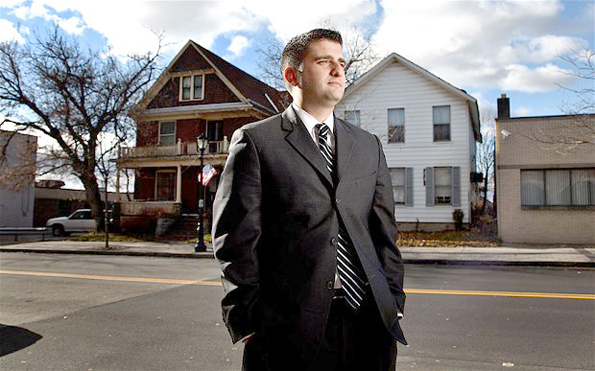
This photo of Piccirillo was published in the Telegraph in England along with the story entitled 'Decline and falls: an American city in crisis’ in December 2012. "Whether Mr. Piccirillo’s plan works remains to be seen. The figures showing rapid decline would suggest not," the Telegraph wrote then.
When Community Development Director Seth Piccirillo announced his plan to actually pay people $3,500 a year for two years if they moved to Niagara Falls, a media firestorm ensued.
Aside from accolades from the three local television stations, the Buffalo News and the Niagara Gazette, the idea was hailed as a bold initiative by media outlets from coast to coast.
The Associated Press, CBS, Forbes, the Huffington Post, Good Morning America, ABC, the San Francisco Chronicle, Fox News and literally hundreds more news outlets got wind of how our "rapidly dwindling city" planned to pay college graduates to come and live here.?
"After the city's old strategy of industry over tourism flopped amid the decline of Rust Belt manufacturing and the disastrous Love Canal, a new economic plan appears to have emerged," the Associated Press story explained. "Try anything."?
And while newspaper and television pundits told their audiences of the city's sad decline, they called the Piccirillo plan "bold," "daring," "broad" and "dramatic." ?The most ridiculous was an ABC news story comparing Piccirillo to Nik Wallenda:
"In Niagara Falls, N.Y., a man shortly will attempt a daring feat…" the correspondent reported breathlessly.
Mayor Paul Dyster took the opportunity to tell the world that, in Niagara Falls, "One in five people live in poverty and the population of 50,193 is less than half what it was in the 1960s."
But despite the Piccirillo plan – and similar schemes to prop up population numbers by importing literally hundreds dangerous sex offenders ?and other violent parolees – have not succeeded in reversing the exodus that began more than a half century ago.
A recently released projection by the U.S. Census Bureau shows that the current population of Niagara Falls is but 49,722 souls, down from the 50,193 who lived here two years ago. The next official census count, which will take place in 2020, could have dire consequences for the city should the population slip below 50,000.
At stake are millions of dollars in state and federal funds that would be lost should Niagara Falls lose its' designation as a city, and that's why the Piccirillo plan was considered so crucial.
Since the initial buzz of publicity, little has been heard of the plan. And there turns out to be a good reason for that. Over the past 19 months, just seven individuals have moved to Niagara Falls despite the promise of the $7,000 stipend.
"The program is going well, but obviously it's not a silver bullet," Piccirillo told the Niagara Falls Reporter in an exclusive interview. "We see it as a part of an overall marketing strategy for the city, just another piece of the puzzle."
Stressing that he receives no additional compensation for administering his brainchild, Piccirillo said that he hopes five additional suckers, um, new residents may be recruited in the spring, when college graduates began looking for real world opportunities.
The $3,500 annual stipend is reimbursable, Piccirillo said, which means it is not paid out monthly but at the end of the year of residency. Still, at nearly $300 a month, the stipend would pretty much cover the rent throughout much of the distressed and impoverished city.
The city keeps no master list of approved landlords, he added, but makes prospective residents aware of rental opportunities that exist in various neighborhoods.
Most of the seven current participants in the program live on Park Place or Third Street, where city subsidized landlords like Craig Avery, John Giusiana and Paul Stephen are able to partially fill the buildings they bought and/or rehabbed with city money with tenants whose rents are also subsidized by the city, Piccirillo said.
It apparently hasn't occurred to Dyster, Piccirillo or anyone else in charge of running the city that, rather than paying people to move into vacant buildings that other people were paid to buy and fix up, public funding might better be spent on simply making the city a more attractive place in which to live.
Certainly, places such as Los Angeles, Seattle, Boston, New York, North Carolina or even Portland, Oregon, aren't paying people to move there. In fact, all over the country, people are scrimping and saving to have enough to move to those places and away from cultural and economic backwaters such as Niagara Falls.
And, unlike the heads of our fair city, community leaders in those places would never consider propping up population figures through the importation of undesirables whose presence serves only to drive decent, hardworking families away.
"Try anything," the Associated Press story said. Indeed.
Paying recent college graduates to come to a place where few opportunities exist for college graduates and opening the door to every degenerate sex criminal, armed robber or paroled killer in order to pathetically maintain city status amounts to trying anything in the most desperate sense of the phrase.
|

